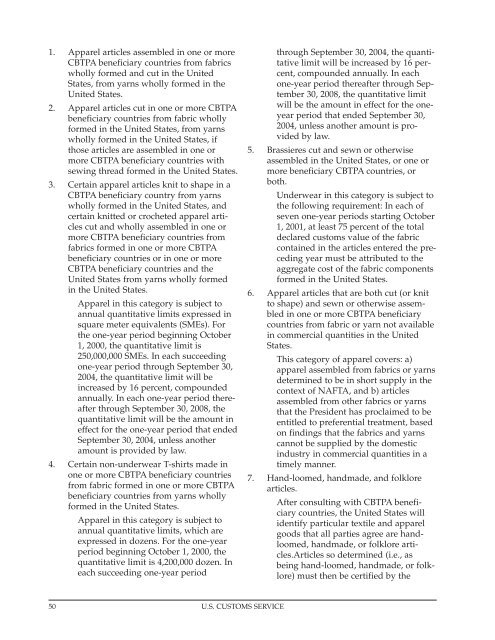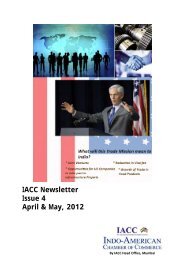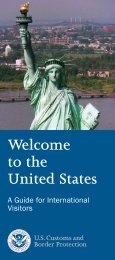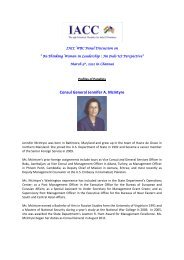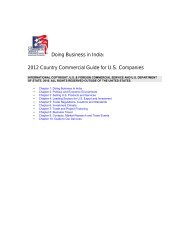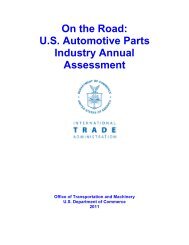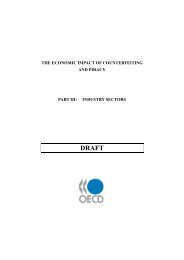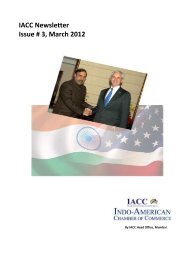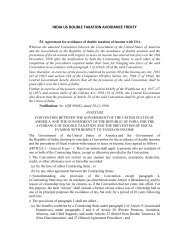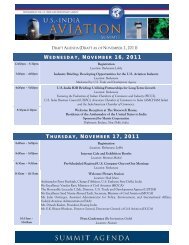Importing into the United States - Indo-American Chamber Of ...
Importing into the United States - Indo-American Chamber Of ...
Importing into the United States - Indo-American Chamber Of ...
You also want an ePaper? Increase the reach of your titles
YUMPU automatically turns print PDFs into web optimized ePapers that Google loves.
1. Apparel articles assembled in one or more<br />
CBTPA beneficiary countries from fabrics<br />
wholly formed and cut in <strong>the</strong> <strong>United</strong><br />
<strong>States</strong>, from yarns wholly formed in <strong>the</strong><br />
<strong>United</strong> <strong>States</strong>.<br />
2. Apparel articles cut in one or more CBTPA<br />
beneficiary countries from fabric wholly<br />
formed in <strong>the</strong> <strong>United</strong> <strong>States</strong>, from yarns<br />
wholly formed in <strong>the</strong> <strong>United</strong> <strong>States</strong>, if<br />
those articles are assembled in one or<br />
more CBTPA beneficiary countries with<br />
sewing thread formed in <strong>the</strong> <strong>United</strong> <strong>States</strong>.<br />
3. Certain apparel articles knit to shape in a<br />
CBTPA beneficiary country from yarns<br />
wholly formed in <strong>the</strong> <strong>United</strong> <strong>States</strong>, and<br />
certain knitted or crocheted apparel articles<br />
cut and wholly assembled in one or<br />
more CBTPA beneficiary countries from<br />
fabrics formed in one or more CBTPA<br />
beneficiary countries or in one or more<br />
CBTPA beneficiary countries and <strong>the</strong><br />
<strong>United</strong> <strong>States</strong> from yarns wholly formed<br />
in <strong>the</strong> <strong>United</strong> <strong>States</strong>.<br />
Apparel in this category is subject to<br />
annual quantitative limits expressed in<br />
square meter equivalents (SMEs). For<br />
<strong>the</strong> one-year period beginning October<br />
1, 2000, <strong>the</strong> quantitative limit is<br />
250,000,000 SMEs. In each succeeding<br />
one-year period through September 30,<br />
2004, <strong>the</strong> quantitative limit will be<br />
increased by 16 percent, compounded<br />
annually. In each one-year period <strong>the</strong>reafter<br />
through September 30, 2008, <strong>the</strong><br />
quantitative limit will be <strong>the</strong> amount in<br />
effect for <strong>the</strong> one-year period that ended<br />
September 30, 2004, unless ano<strong>the</strong>r<br />
amount is provided by law.<br />
4. Certain non-underwear T-shirts made in<br />
one or more CBTPA beneficiary countries<br />
from fabric formed in one or more CBTPA<br />
beneficiary countries from yarns wholly<br />
formed in <strong>the</strong> <strong>United</strong> <strong>States</strong>.<br />
Apparel in this category is subject to<br />
annual quantitative limits, which are<br />
expressed in dozens. For <strong>the</strong> one-year<br />
period beginning October 1, 2000, <strong>the</strong><br />
quantitative limit is 4,200,000 dozen. In<br />
each succeeding one-year period<br />
through September 30, 2004, <strong>the</strong> quantitative<br />
limit will be increased by 16 percent,<br />
compounded annually. In each<br />
one-year period <strong>the</strong>reafter through September<br />
30, 2008, <strong>the</strong> quantitative limit<br />
will be <strong>the</strong> amount in effect for <strong>the</strong> oneyear<br />
period that ended September 30,<br />
2004, unless ano<strong>the</strong>r amount is provided<br />
by law.<br />
5. Brassieres cut and sewn or o<strong>the</strong>rwise<br />
assembled in <strong>the</strong> <strong>United</strong> <strong>States</strong>, or one or<br />
more beneficiary CBTPA countries, or<br />
both.<br />
Underwear in this category is subject to<br />
<strong>the</strong> following requirement: In each of<br />
seven one-year periods starting October<br />
1, 2001, at least 75 percent of <strong>the</strong> total<br />
declared customs value of <strong>the</strong> fabric<br />
contained in <strong>the</strong> articles entered <strong>the</strong> preceding<br />
year must be attributed to <strong>the</strong><br />
aggregate cost of <strong>the</strong> fabric components<br />
formed in <strong>the</strong> <strong>United</strong> <strong>States</strong>.<br />
6. Apparel articles that are both cut (or knit<br />
to shape) and sewn or o<strong>the</strong>rwise assembled<br />
in one or more CBTPA beneficiary<br />
countries from fabric or yarn not available<br />
in commercial quantities in <strong>the</strong> <strong>United</strong><br />
<strong>States</strong>.<br />
This category of apparel covers: a)<br />
apparel assembled from fabrics or yarns<br />
determined to be in short supply in <strong>the</strong><br />
context of NAFTA, and b) articles<br />
assembled from o<strong>the</strong>r fabrics or yarns<br />
that <strong>the</strong> President has proclaimed to be<br />
entitled to preferential treatment, based<br />
on findings that <strong>the</strong> fabrics and yarns<br />
cannot be supplied by <strong>the</strong> domestic<br />
industry in commercial quantities in a<br />
timely manner.<br />
7. Hand-loomed, handmade, and folklore<br />
articles.<br />
After consulting with CBTPA beneficiary<br />
countries, <strong>the</strong> <strong>United</strong> <strong>States</strong> will<br />
identify particular textile and apparel<br />
goods that all parties agree are handloomed,<br />
handmade, or folklore articles.Articles<br />
so determined (i.e., as<br />
being hand-loomed, handmade, or folklore)<br />
must <strong>the</strong>n be certified by <strong>the</strong><br />
50 U.S. CUSTOMS SERVICE


